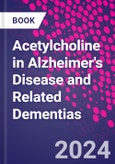Table of Contents
1. Anatomy of the basal forebrain cholinergic (BFC) system in rodents and primates, including humans 2. Input-output relations of BFC neurons 3. Cholinergic receptors: neurobiology and functions 4. Dementias 5. Neuropathology of AD 6. Cholinergic deficit in AD 7. Relationship between cholinergic loss, pathological lesions in AD and dementia 8. Progression of the disease, clinical-pathological correlations in MCI/AD 9. Pathology of the aging brain in relation to AD 10. Amyloid deposition with large-scale human network dysfunctions in aging and AD 11. APP processing, �-amyloid, a,�,? secretases, notch signaling 12. ?-amyloid production, secretion, oligomerization, clearance/export, degradation 13. Synaptic vesicle cycle and �-amyloid: intracellular trafficking, retromer sorting, autophagy 14. Tau phosphorylation, NFTs, axonal transport 15. The wnt-GSK-3 signaling, presenilin, tau 16. Apolipoprotein, LRP receptors, lipid homeostasis 17. ApoE alleles, gene mutations in AD 18. Microglia activation, inflammation 19. Epigenetic mechanisms in AD 20. Transgenic mice models in AD 21. Pathogenetic (mechanistic) schemes 22. Current therapies in AD 23. Vulnerability and repair of BFC neurons, early attempts 24. Biochemical pathways linking muscarinic, nicotinic receptors with APP cleavage and phosphorylation of tau 25. NGF, TrkA, p75, neurobiology, transport and signaling in cholinergic neurons 26. Homeostatic clearance of A� mediated via p75 receptor uptake and degradation in BFC neurons 27. Cell cycle proteins in BFC cells 28. Dual, neuromodulator and homeostatic role of BFC system 29. Atrophy of BFC compartments and relation to cognitive impairment in MCI/AD 30. Volume of Ch1/2 is predictor of conversion from MCI to AD 31. Summary and concluding remarks








